Note
How did you create the script for Seraphic? What tools did you use?
I basically just sketches it out in a notebook! It took quite a while to get it right, I had a lot of ideas but wasn't quite sure how exactly I wanted to executed it. I wanted vowels and consonants to be incorporated into each other in some way, and I also wanted it to be very segmented and out into syllabic blocks like Korean Hangul, which wasa big inspiration. I had to play around a lot with how words would look, and how to arrange each syllable block, but since canonically the script was artifically made and is featural I didn't really worry TOO much about it looking naturalistic. With the older Seraphic scripts, I naturally evolved those and that gave me a good idea of the aesthetic of Collective Seraphic that I wanted. I knew I also wanted to make it be more symbolic that just purely spelled out too, holdovers from the older scripts that I wanted to bring over. I also enjoyed the idea of it beings theoretically written with some sort of flat-tipped pen, giving jt that thin-thick brush shape, even though it's mostly a digital script with physical writing falling out of contemporary use. Otherwise, it was mostly just me being creative and playing around with aesthetics and making it look nice while I also being logical to both write and read it.
With the older scripts, especially proto-Seraphic, I since it would've been imprinted into clay I did get some clay and a butterknife and made the glyph shapes in it. I had the ideaographic forms down, and just translated that to the more angular form of clay imprinting, and went from there. It does help to work with the medium of the writing systme you're using, because that does determine how they evolve.
#ask#multiversetravelingjournalist#conlang#constructed language#conscript#constructed script#seraphic#neography
2 notes
·
View notes
Text
The Erelian Script has a very long history, stemming back thousands of years and across many cultures and another planet. There are eight notable stages of the development of Erelian writing that I'll go into detail about, as each stage marks a sharp change in the regular use of the script, as opposed to more gradual changes over time.

This is the development path for the Erelian letter A, which is pronounced as /ɑ/. It's one of the letters who's pronunciation has remained relatively consistent throughout time.

Pre-Proto-Seraphic Glyphs
The first glyphs recognized to carry semantic content. These first glyphs were ideograms, used mostly for labeling, inventory, religious rites, supernatural charms, and other simpler uses. They would've been etched into stone or painted using dyes made of local plants or animal blood. This glyph specifically would've conveyed the meaning of "all" or "whole", depicting a jar or cauldron with a lid on top.

Old Proto-Seraphic Bark Etchings
As writing was developing more, and glyphs becoming more complicated, the glyphs began to drift away from ideograms and logograms and make use of more phonetic elements. This glyph was used for the word "whole", but also represented the glottal stop /ʔ/ when used phonetically. Proto-Seraphic writing began to be written on the dried bark of paper tree, etched into the bark and dyed by way of similar tanning processes used for animal hides. This paper was more fragile than stone, but much easier to replace and less time-consuming. As it went into regular use, the seraphim found it inconvenient to hold the very long strips of paper in the usual horizontal fashion, reading right-to-left and top-to-bottom in reverse boustrophedon and constantly turning it on its side when writing, so they began to read it at a perpendicular angle going from right-to-left to bottom-to-top

Proto-Seraphic Writing
At some point, the Proto-Seraphic culture migrated from further in the continent towards a vast group of islands and coasts. Since they did not regularly practice agriculture, and paper trees did not produce seeds, they could not bring their original writing commodity with them. Thus they began using a thing stylus called a hwituyáw to make impressions into wet clay, which they would then either let dry or bake to make more permanent. The writing system changed in the following millenia to accommodate this, largely abandoning logograms and maintaining a majorly phonetic system, with a few exceptions remaining for lexical use. As Proto-Seraphic culture grew and advanced, and trade with foreign powers became more necessary, writing became a much more prevalent thing in society. A majority of late Proto-Seraphic writing comes from this period in history on surviving tablets, inscriptions on buildings, and earthenware. This glyph took on the role of the glottal stop /ʔ/, as well as the vowel /ɑ/.

Old Seraphic Writing
With the large amount of influence Seraphic culture took from surrounding cultures, they soon gained access to brush and pulp paper, and use of it was considered a symbol of the elite. At this point, the writing started to become much more fluid and rounded, and many stylistic variants are produced. The Soverign Conquest contributes to the spread of Seraphic language and culture across much of the world, and many languages adopt the Seraphic alphabet. At this point, Proto-Seraphic transitions into Old Seraphic.

Ealry Aeonic Seraphic Alphabet
This variety stems from the early industrial revolution. Brushwork largely falls out of use in favor of pigment and ink sticks, similar to pencils and pens. The forms become much more rounded and simplified, and variants begin to standardize to this form. As literacy becomes more prevalent in Seraphic society, and more and more people are expected to be literate, the writing system undergoes several spelling reforms, introducing things such as diacritics.

Aeonic Seraphic Alphabet
During the technological revolution, as Seraphic transitions fully into Aeonic Seraphic, the letters become fully standardized. Aeonic Seraphic becomes the lingua franca for much of the Homeworld, and these forms remain consistent throughout much of the Celestial Revolution which marks the seraph race's beginnings as an interplanetary species. Aeonic Seraphic is carried over as a continuing lingua franca to their first planetary colony; Erel.
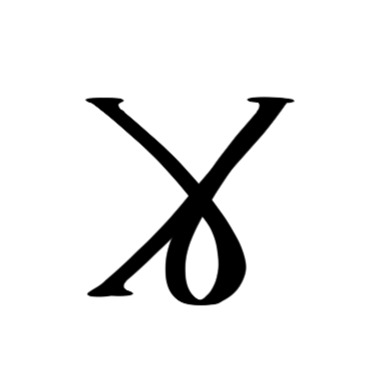
Old Erelian Alphabet
Due to Erel's population being largely separate from the Homeworld, the language naturally begins to shift into its own dialect, and eventually language. As the Collective adopts the Collective Seraphic script, Erelian continues to use the native Aeonic Seraphic script which develops further and further as the Erelian culture and identity becomes more solid. The shape becomes less round and more linear to match the aesthetic of the Collective Seraphic Script.

Modern Erelian Alphabet
The alphabet finally takes its final form, becoming much more linear and simplified to accomodate smaller text sizes. Many other newer languages and dialects will adopt either the Collective Seraphic script or the Erelian script to accommodate them.
11 notes
·
View notes
Text
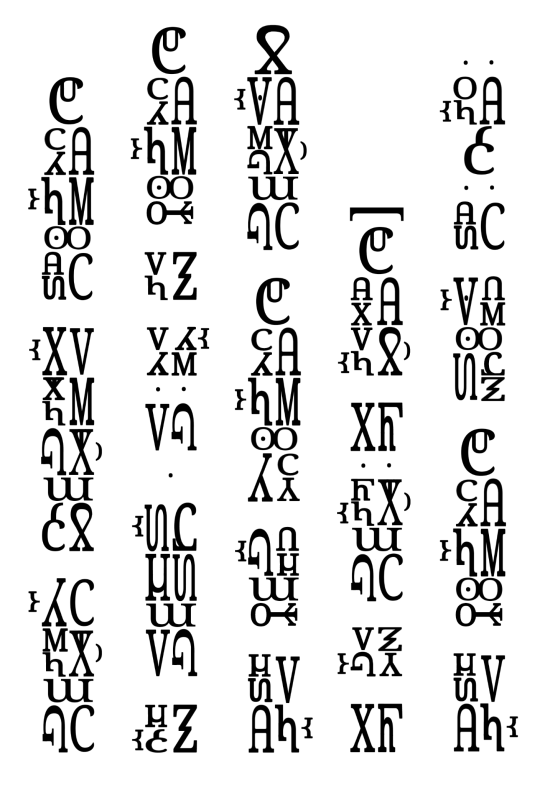
A mockup for what I'd want the digitized aesthetic of my new language Erelian to look like. It's a sister language to Collective Seraphic, both stemming from Aeonic Seraphic, and uses an evolved form of the Aeonic Seraphic script. This is definitely not the final look of the writing system, and I want to tweak some things here and there. It's a translation of article 1 of the UDHR, translation info below
Édnol-odzédæpf two’zbń pod’udém’qa stìn pi’ǰèq’qa čèndadf. Édnol-relbì spæ’zédæpf pi’ǰizdǹš tùl in’olwò, in’Zæ̀æn ten-odzédæpf pi’ǰezpǽ šu’ǰizežnà pod'zédæpf nul.
/ɛ́dᵊ.nɔɫ ɔd.d͡zɛ́.dapᵊf tʷɔ.d͡zᵊbń̩ ˌpɔd.ʊ.dɛ́m.qɑ t͡sᵊtɪn pɪ.ʝɛ̀q.qɑ çɛ̀n.dadᵊf | édᵊ.nɔɫ rɛɫ.bɪ̀ t͡sᵊpa.d͡zɛ́.dapᵊf ˌpɪ.ʝɪd͡zᵊ.dǹ̩s tʊɫ ˌɪn.ɔɫ.wɔ̀ ɪn.d͡zàən tɛn ɔd.d͡zɛ́.dapᵊf ˌpɪ.ʝɛd͡zᵊ.pá sʊˌʝɪ.d͡zɛzᵊ.nɑ̀ pɔd.d͡zɛ́.dapᵊf nʊɫ/
GNO DYN-seraph-COL out.of=egg as=free and=equal with=dignity and right-COL || GNO DYN-help for=seraph-COL with=thought-PL reasonable ADJ=ethic | ADJ=same FUT DYN-seraph-COL with=reason of=friendship DAT=seraph.COL other
"All human beings are born free and equal in dignity and rights. They are endowed with reason and conscience and should act towards one another in a spirit of brotherhood."
23 notes
·
View notes
Text

The Litany Against Fear (Awaman Cni-ŁK'āmf) from Dune in Collective Seraphic
Má n̄zafl cni-lxal.
Łk'āmf in-yux ednr ezrezaxer.
Łk'āmf ednr aznlayux tsl nar nezłk'an ‘ōvn e-zāfl.
Tcān zāfl pn̄-łk’āmf edzt'a.
Tcān zāfl in-ut'ēn relk'āmf aznzoxl kxun-zāfl kā tun-zāfl.
Kā fr-fi nar ŋ̄ğōzłk'āmf fān-zāfl, tcān zāfl pn̄-oxl ēdsīn cu-zāxer ezrefar pi-sīman.
Tu dānjt’u e-fe nar nezłk'āmf fān-vafl.
danZafl cu-yú īn-hōn.
"I must not fear.
Fear is the mind-killer.
Fear is the little-death that brings total obliteration.
I will face my fear.
I will permit it to pass over me and through me.
And when it has gone past, I will turn the inner eye to see its path.
Where the fear has gone there will be nothing.
Only I will remain."
#conlang#constructed language#conscript#constructed script#dune#seraphic#collective seraphic#neography
25 notes
·
View notes
Text
Made a thing of an intercom announcement in a teleportation warp hub, because I can. Probably could've done better, but I need to use the best take the moment I get it. Here's a transcription and translation:
"Asl nliwayeğo cu-Vulvren cu-Lijaxel cāza-Vofağláf, vujt'al cu-Livmanznaf cu-Łt'ējn: tsa-levp'ā cu-lezrağn cu-ācèya, āgxōnr azmvlacwœ tcē-yú-wal xel-Verel fr-lce cu-abravrk'ūn pux-lejni tsa-lce yú. Má ēdzējağleyāf cu-flacwœ tcē-yú-wal xel-flacwœ ālxōr. T'ezl ēzr̄fl pi-lisa, má ēdzējağleyāf cu-flacwœ tcē-yú-wal xel-flacwœ ālxōr. Lcanznin tlezn tsa-avren fl. mVulvren cu-Lijaxel cāza-Vofağláf cu-stux ‘ōf tsa-levp'ā nar nedzasláf kxun-flacwœ, kā tcān danloxel cni-lesar tsa-zāsláf."
"This is an announcement from the Department of Interplanetary Transportation, a subdivision of the Ministry of Progress: due to system malfunctions, gate 2-1-3 bound for Erel at 16:00 has been delayed by one hour. All passengers boarding gate 2-1-3 must proceed to gate 16. Once again, all passengers boarding gate 2-1-3 must proceed to gate 16. Our deepest apologies for this inconvenience. Thank you for teleporting with us today, and we hope you have a safe warp."
#conlang#constructed language#artlang#artistic language#seraphic#collective seraphic#audio#linguistics#yes im very cool and with it thank you for noticing
18 notes
·
View notes
Note
Japanese does this as well! If you want to join two nouns, you use the particle と (e.g. 犬と猫 "dogs and cats"), but if you want to join two clauses you would put the verb of the first clause into the -te form, and the second clause would be written normally (e.g. 私は起きた。私は朝ご飯を食べた。"I woke up. I ate breakfast." vs. 私は起きて朝ご飯を食べた。"I woke up and ate breakfast."). If you want to connect two separate whole sentences, you could use the conjuction そして as well!
If a language had two different "and"s, one for grouping (alice AND bob) and one for joining clauses (we went there AND did the thing), is there existing terminology for such a situation?
I don't know what the terminology would be, but languages do this all the time. The difference is phrasal coordination and clausal coordination. In English, the same strategy is employed, but many languages use a different strategy—Latin, for example (et is for clauses, but noun phrases, for example, were more often coordinated with the suffix -que being applied to the last element in a phrase chain).
93 notes
·
View notes
Text
The Collective Seraphic Writing System
This post is going to be the one dedicated to explaining how the Seraphic writing system works. This writing system is entirely digital, as physical writing is no longer in everyday use throughout the Collective, so it's a bit inconvenient to actually write out. It's also weird to read, because it's written in a way that makes the assumption that you know how to speak and understand Seraphic, but I'll try to explain what I can.
Seraphic has two written forms: longform and shortform. Longform is used primarily to teach young instars how to read and write, and as a way to show how a shortform word is meant to be read. Shortform is the main form of writing, and due to its complication it's usually put off for a year or two before being taught in pupariums. Shortform is the method I'll be teaching today. It's primarily morpho-phonetic, with elements of both an alphabet and grammatical logograms, and is written bottom-to-top and right-to-left in reverse boustrophedon (the path of writing goes up, flips 180°, and goes back down). Because of this, you're expected to be able to read both right-side-up and upside-down. For this post, I'll be using an example sentence to highlight specifics areas of the writing system, as shown below:

It reads: nJasāğn k'œ̄nan ālxōr e-fya.
"There are 16 dull knives on the floor."
There are seven elements you need to be aware of when writing in Seraphic: the alphabet, class cartouches, procedural and plural ligatures, preposition glyphs, tone diacritics, numerals, and punctuation. I'll be going through each one step-by-step.
Alphabet

The alphabet makes up the majority of Seraphic writing. There are 30 consonants and 6 vowels, and they all arrange into syllable blocks called "cells". Each consonant takes one of three forms depending on if it is at the start of the syllable, before a vowel, or at the end of a syllable. The alphabet is featural, meaning that the way each letter is written is meant to encode its pronunciation. Here is the alphabet in full:

Each consonant (excluding the ejectives) showcases the three variant forms it can take (similar to capital and lowercase letters in the latin alphabet). The largest, leftmost character is the form that hosts the interior vowels within it. The rightmost vertical form is used when preceeding another consonant, and the upmost horizontal form is used at the end of syllables. If a syllable contains a syllablic consonant, the main consonant will have no vowel within it and instead a syllable-final form of one of the syllabic consonants (r, l, m, n, or ŋ) placed on top of it.

Concerning vowels, they are solely meant to be written within consonants, acting sort of like internal diacritics. They cannot exist on their own, nor can more than one be written within the same consonant (Seraphic doesn't allow diphthongs), and if a vowel must be written by itself it is written within the glottal stop letter ' (in this instance acting as an independant vowel holder).

These rules apply to individual syllables. In multi-syllabic words, each syllable cell is arranged together in a specific way based on the number of syllables in order to keep the line uniform and compact.
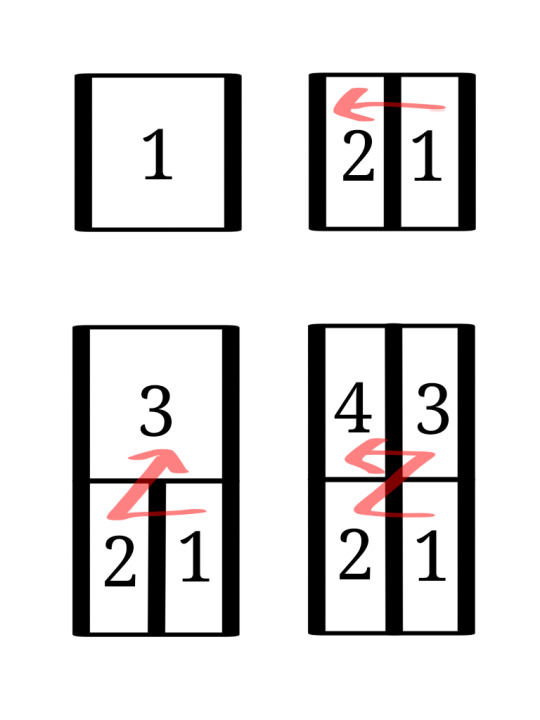
the flow of reading word-internally definitely follows the overall direction of writing (bottom-to-top, right-to-left) so broken down an entire word will usually look like this when written:

Seraphic written in longform will be written entirely using the alphabet. Spaces are put between words, punctuation and numeral symbols are still used, and tone diacritics may be included as well, but otherwise it's entirely spelled out in this way. Writing this way makes the text as a whole quite longer, and can come off as childish or imply you're a new learner of Seraphic, so shortform will usually be used in official contexts. In shortform, alphabetical letters are restricted to non-declined parts of nouns, adjectives, and proper nouns.
Class Cartouches

In Seraphic, there are seven noun classes: Solar (people), Astral (animals), Vital (plants), Terranean (places), Metallic (objects), Lunar (concepts), and Oceanic (everything else). Similarly, the writing system employs seven symbols called "class cartouches" to encode which noun class a word is in. This is drawn from this writing system's predecessor, the Aeonic Seraphic alphabet, that also used glyphs to notate class. These are the seven noun class cartouches:
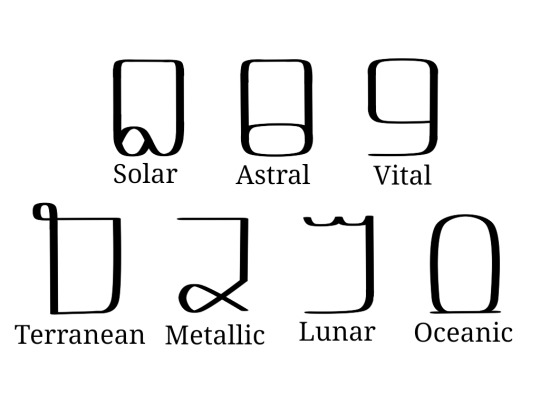
The thing about the class cartouches is, not only is it morphological, but it's also phonetic. A noun is never spelled out in its entirety, usually only part of it is. When a class cartouche is used, it's supposed to stand in for the class prefix itself without having to additionally spell the class prefix in the rest of the word. For example, in the word zājlux (tail), the "-jlux" would be spelled out, and the solar class cartouche would be drawn around it to stand in for the "zā-". Even though you don't write it, you still know it's there because of the class cartouche. Because of the nature of the noun class prefixes, and how many different forms they can take, it can be daunting to have to guess if you're supposed to pronounce a word with a "za-" or a "zo-", but there are patterns to which prefix (and thus, declension patterns), is meant to be read depending on what the following sound is.
Solar class
read as zā before f, v, s, z, c, j, pf, ts, tc and any cluster of two consonants (e.g. zāsā, zāfr, zājlux)
read as zō before x, ğ, h, ', and kx (e.g. zōxō, zōxur, zōğœcl)
read as zē in stressed syllables, and occasionally before consonant clusters (e.g. zēzmp'ux, zēzt'e, zēvasax)
read as s before vocalics (vowels and syllabic consonants), r, l, w, y, n, t, d, p', or k' (e.g. srāc, sēr, sōğœc)
read as ts before t', the ts replacing the t' entirely in pronunciation, for example tsn would be written as (Solar)t'n (e.g. tsn, tsā, tsłzaf)
Astral class
read as ğr before f, v, s, z, c, j, x, ğ, h, pf, ts, tc, kx, p', t', k' and and cluster of two consonants (e.g. ğrzles, ğrxur)
read as x before vocalics, r, l, w, y, ŋ, k, g, p', or t' (e.g. xūc, xŋox)
read as kx before k', the kx replacing k' in pronunciation (e.g. kxa)
Vital class
read as wā before r, l, w, or y (e.g. wāya, wārāc, wāwax)
read as wō before k', k, g, x, ğ, ŋ, or kx (e.g. wōk'ł, wōxur, wō'ōf)
read as wē before consonant clusters (e.g. wēzles, wējlux, wējlozln)
read as ū before n, m, p', p, b t', t, d, f, v, s, z, c, j, pf, ts, or tc (e.g. ūt'u, ūp'n)
read as w before vocalics (e.g. wē, wīn, wājr)
read as wī occasionally before consonant clusters (e.g. wīzya)
Terranean class
read as va before f, v, s, z, c, j, pf, ts, tc and any cluster of two consonants (e.g. vafl, vasērn, vasa)
read as vo before x, ğ, h, ', kx, and consonant clusters (e.g. voxāl, vodsā, vojrayux)
read as vu in stressed syllables and occasionally before consonant clusters (e.g. vujlux, vulvren, vuzajni)
read as f before vocalics, r, l, y, w, m, n, ŋ, p, b, t', or k' (e.g. fe, fruvn, fmağo)
read as pf before p', pf replacing p' in pronunciation (e.g. pfan)
Metallic class
read as ja before f, v, s, z, c, j, pf, ts, tc and any cluster of two consonants (e.g. jafa, javlni, jawaya)
read as jo before x, ğ, h, ', and kx (e.g. joxl)
read as c before vocalics, r, l, w, y, n, t, d, p', or t' (e.g. can, cya, cenaŋx)
read as tc before t', the tc replacing the t' entirely in pronunciation (e.g. tcłvr, tcāŋğl, tcū)
Lunar class
read as la before r, l, w, or y (e.g. lara, layeğr, lalel)
read as lo before k', k, g, x, ğ, ŋ, or kx (e.g. loxir, loğn̄, loxel)
read as le before consonant clusters (e.g. levp'ā, levren, lejt'ān)
read as li in stressed syllables and occasionally before consonant clusters (e.g. liwayi, lit'n̄, livasāx)
read as y before vocalics (e.g. yar, yu, yawu)
read as l/ł before n, m, p', p, b t', t, d, f, v, s, z, c, j, pf, ts, or tc (e.g. lce, łzēwok'u, lvulvren)
Oceanic class
read as a/ā before m, n, p', p, b, t', t, d, s, z, f, v, c, j, pf, ts, tc, w, r, y, l, and all consonant clusters (e.g. ap'i, āt'ē, ācèya)
read as o/ō before ŋ, k', k, g, ', x, ğ, h, and kx (e.g. ōxūr, ōxān)
read as aw/āw before vocalics (e.g. awun, awaf, awaman)
Of course these rules are not hard set, and there are several instances where a written word contradicts these rules or even when two words end up spelled the same, but for the most part these rules will generally be consistent for most written words. It seems like a lot to remember, but usually it's a thing that you eventually develop a sort of "ear" for.

Procedural and Plural Ligatures

The procedural and plural ligatures are additional glyphs used to mark, respectively, the procedurals and the plurals of a noun. The procedural are written at the bottom of the noun (since Seraph is written bottom-to-top and these are prefixes of course), and there are 12 separate procedural symbols in use. Similarly, the plurals, being suffixes, are written at the top of the noun and contain only three symbols (the singular is usually unmarked). They are as follows:
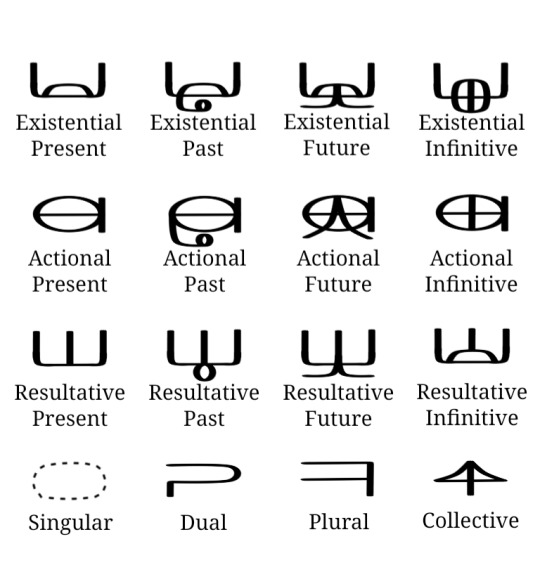
The plural ligatures attach to both nouns and adjectives freely, but in order for a procedural ligature to attach to an adjective, the adjective needs to be put in the oceanic class and subsequently written with the oceanic class cartouche. Additionally, if you want to write remote past/future forms for each procedural, you would need to attach the resultative present ligature underneath the preexisting past or future ligature (these conjugations haven't developed their own separate ligature forms, so they follow the tradition of using the resultative in addition as semantically that is where the remote forms originated). I don't really have a way to show you how to pronounce the plural forms, as even though the different pronunciations are pretty few they're actually pretty inconsistent on which one goes where. It's just one of those things you kinda have to already know. You can check the introduction to Seraphic post to see what forms the plurals can take, but otherwise it's basically, like, memorization. The procedurals on the other hand DO have a predictable pattern of pronunciation, but each tense has a different form based on what class and declension the noun is in, and with six tenses and seven classes each with at least three different declension forms, it's definitely something I can't summarize here. Again I HAVE to make a separate post for that because the declension forms are vital to knowing how to decline properly in Seraphic.
Preposition Glyphs

This section will probably be the easiest to explain really. The preposition glyphs are pretty easy to recognize. They're written in between words, attaching to both of them instead of floating freely like regular words are. There are 19 glyphs for the 19 prepositions, and they don't really change form. Sometimes, if occurring at the beginning of a sentence, they'll have one end sorta lopped off, but not everyone follows through with this convention. Here are the glyphs listed below:
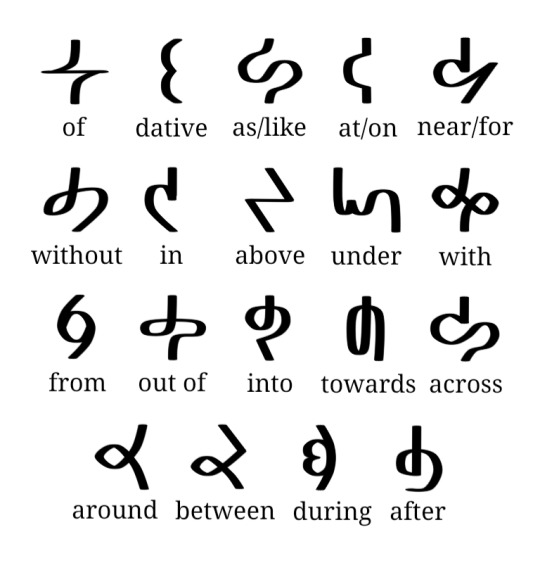
Two or more prepositions can't occur sequentially, it's a very one-at-a-time situation, although in colloquial speech you'll see two prepositions being used in certain instances.
Tone Diacritics

Seraphic is a tonal language, and luckily it has diacritics to indicate the tones. They frame the words on each size, being used on both nouns and adjectives where applicable. You'll usually see them in formal contexts like government documents and letters of address, on signs and boards and menus and any kind of display especially in highly populated areas, in use by those whom are just learning Seraphic and don't have a hang on remembering all of the tones yet, and just in any context where clarity of literacy would be important. In everyday colloquial text conversations and things the tone diacritics will be usually dropped as context is sufficient enough to know, although tone diacritics may be reintroduced to differentiate homonyms that are distinguished only in tone (e.g. lxal "power" vs. łxāl "day"). There are eight individually recognized tone diacritics:

The low tone is the base tone and is usually left unmarked, so there's no sign for just the low tone. When a low tone transitions to a rising or falling though, the low transition diacritic will be used to connect the two. Many of these diacritics are usually connected consecutively when a word requires it, flowing as if they're one larger tone diacritic. This can give a whole host of unique tone symbols, but for the most part, all of the tone symbols can be broken down officially into the 8 diacritics. There isn't a 1-1 correspondence between individual tone diacritics and syllables within a word, usually you can know from context and just knowing how the word is pronounced. For example, the word łxāl would be written with one high tone marker even though the word is two syllables, but it's meant to infer that the entire word is pronounced with an even high tone. Here are some additional examples:
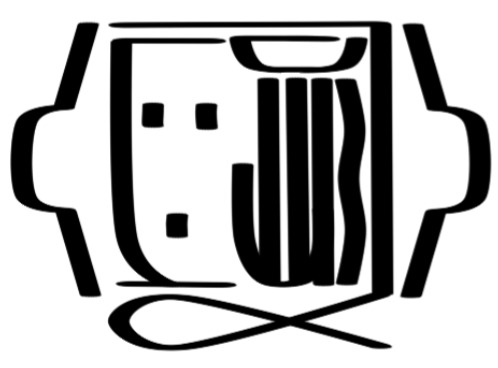
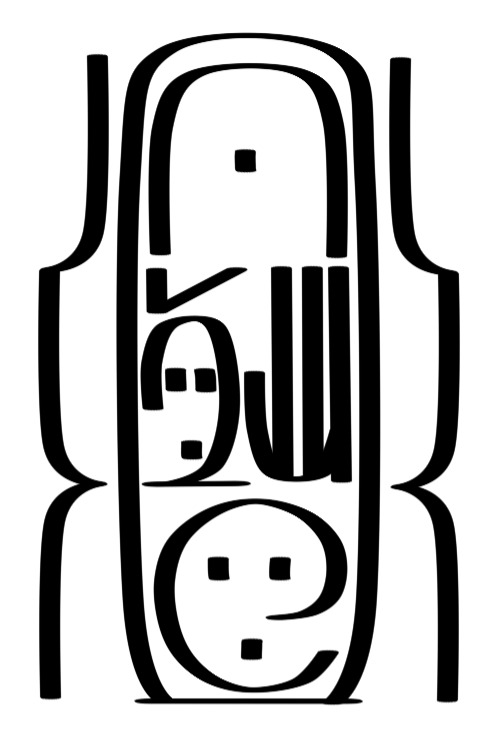
The top example is the word jalzègxa "chronicle". You can see that it uses the two low tone transitions to connect to the central falling tone, representing a low-falling-low relationship. The word below that is māzefādnu "hourglass". It employs a high-low-high, and then a high-low, with the last high-low meant to merge with the high-low-high. So truthfully it's meant to be interpreted as high-low-high-low. There's a lot of possibilities, but breaking it down will simplify what tones are being used specifically.
Numerals and Punctuation

This final section will discuss Seraphic numerals and punctuation. Now, unlike in most human languages which uses base-10, having 10 unique symbols to represent the values of 0-9, Seraphic uses base-16 and represents the values 1-16 with 16 individual symbols. In base 16, we would write 16 as 10, standing for one set of 16 and zero sets of 1. It's written in positional notation like arabic numerals, where each position represents a power of 16 (instead of a power of ten like in base-10). Here are the numerals:
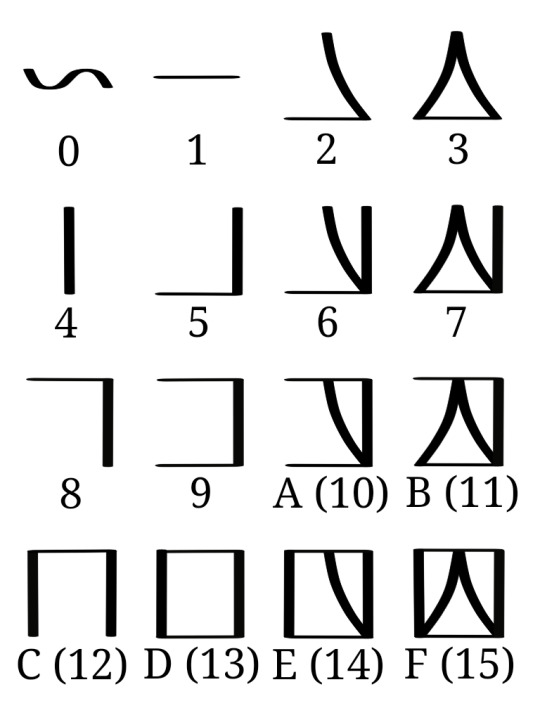
If you were to write a number like 299,792,458; you'd convert it into base-16 which would be 11,DE7,84A; and since Seraphic numerals are grouped in 4 instead of 3 it would actually be 11DE,784A. This is how you'd write that:
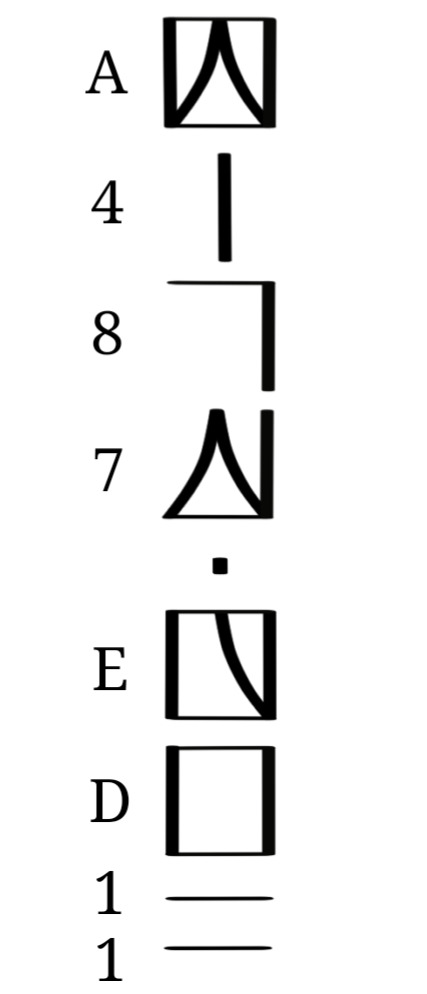
Both Arabic numerals and Seraphic numerals describe the same amount of things, they just group things differently. We group in sets of 10, they group in sets of 16.
As for punctuation, there are only 5 marks that's in standard use, and these are them:
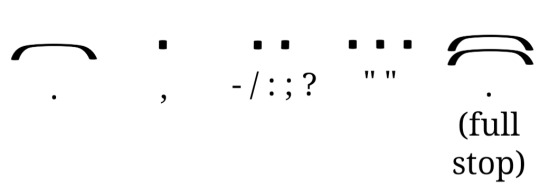
Single bar - separates individual sentences.
Single dot - separates clauses for clarity, separates numerals into groups of four.
Double dot - separates individual words such as in lists or replaces a single dot when separating clause groups.
Triple dot - Distinguishes quotes and dialogue, as well as highlighting names, terms, and titles.
Double bar - used to end full paragraphs/passages instead of a single bar.
Overall, that's pretty much everything I can detail about how the Seraphic writing system works! It's complicated but it was very fun to develop and boy was it satisfying to get it to work. Hopefully you'll now be able to decode a little better Seraphic writing, and maybe even write something of your own!

ŋKowīci cu-stux 'ōf tsa-levp'ā cu-zāsláf pi-lizt'n ğōdjasa! (Thank you all so much for reading!)
#conscript#constructed script#neography#conlang#constructed language#artlang#writing system#orthography#seraphic#collective seraphic#whoa boy this one is even longer#had to do a lot of writing and doodles for this#of course i needed them so itd all make sense#i needed to provide examples#either way i hope this made any sort of sense#ill provide the declension forms soon enough and that should be relatively shorter#idk if it'll be easier to explain though#eh whatever
42 notes
·
View notes
Text
Introduction to Collective Seraphic
Now that Seraphic's at a stable place, I think I'm gonna take some time to delve into the basics of how it operates. For this post I'll only be going into the language itself and not the writing system, as that's going to need a post of its own to elaborate on. I'll try to keep this as concise as possible, but I may make separate posts expanding on topics discussed in this one. So, without further ado, onto the infodump!
Background
Collective Seraphic (which I'll be referring to as "Seraphic") is an artlang that I've created for a comic that as of this post I have not began yet, but am still developing. The majority of the comic will take place on the Seraph Homeworld, an alien planet some 3,000 lightyears from Earth populated by the seraph species (pictured below):

Within the story, Seraphic acts as the lingua franca of the Seraph Homeworld and the many colonized planets under Seraph control. It's used in the government, and among speakers of differing languages. As such, this language was the first one that I knew I would need to make as it will play a vital role in both the storytelling and narrative structure.
Syntax
Seraphic is largely a fusional language, employing affixes to modify the semantic role and meaning of morphemes. Seraphic does not, in the traditional sense, have verbs, so the sentence structure is strictly subject-object (will expand upon later). Nouns decline for number and tense, and are grouped into seven noun classes. Adjectives agree with nouns in number, except if derived from nouns themselves, in which case they'll also agree in class. Seraphic is very head-initial; with demonstratives, numerals, possesives, adjectives, genitives, and relative clauses following the noun the modify; and prepositions preceeding the nouns they modify. Auxiliaries preceed procedurals (again, will expand upon later).
Phonology
Here is the phonological chart for Seraphic:
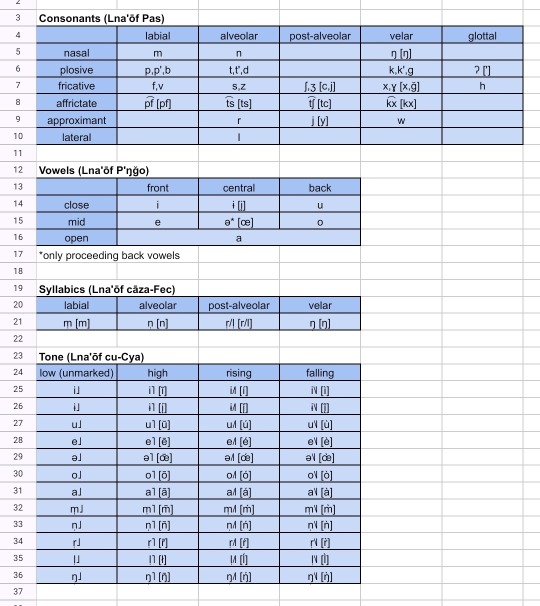
It has a syllable structure of (CC)V(CC). Plosives cannot exist word finally, clusters of consonants of the same manner are illegal, and vowel clusters are also not permitted. Syllabic consonants are grouped with vowels and behave much like them, carrying tone and stress, so they together are grouped and referred to as vocalics. Seraphic is a tonal language, employing the use of four tones: rising (á), falling (à), high (ā), and low (a). Low tones remained unmarked in both the Seraphic script and in romanization. Stress is syllable-independant. It will take either the ultimate, penultimate, or rarely the antepenultimate. Stress always falls on the syllable with a voiceless initial obstruent nearest to the end of the word. If none are available, it will fall on the syllable with an initial sonorant within the same parameters. Stress will never fall on a voiced obstruent. For clarity, I'll provide a key describing the pronunciation of the romanization.
Sounds that are similarly pronounced as they're read in American English:
m, n, p, b, t, d, k, g, f, v, s, z, y, w, l
Sounds that have special pronunciations:
ŋ, like the ng in English "sing"
p', like the ጴ in Amharic "ጴጥሮስ"
t', like the t' in Navajo "yá'át'ééh"
k', like the კ in Georgian "კაბა"
', like the the space within English "uh-oh"
c, like the sh in English "sharp"
j, like the s in English "measure"
x, like the gh in English "ugh"
ğ, like the γ in Greek "γάλα"
pf, like the pf in German "Pfirsiche"
ts, like the z in Italian "grazia"
tc, like the ch in English "chain"
kx, like the kh in Lakota "lakhóta"
r, like the rr in Spanish "perro", although occasionally like the r in Spanish "amarillo"
i, like the ee in English "meet"
į, like the ы in Russian "ты"
u, like the oo in English "boot"
e, like the é in French "beauté"
œ, like the a in English "Tina"
o, like the o in Classical Latin "sol"
a, like the a in English "bra" although this can change to be more forward or more backward.
Another letter that might trip people up is ł, which is meant to represent the high tone syllabic 'l'. Otherwise, syllabics are written the same as their pulmonic counterparts, with tone markers written when applicable.
Nouns
Nouns make up the bulk of the Seraphic lexicon. Every noun is grouped into one of seven classes:
Solar class: nouns related to seraphim or seraph-like beings, and seraph body parts. Prefix appears as zā-, zō-, zē-, s-, or ts-.
sēr = "person"
Astral class: nouns related to non-seraph animate lifeforms (their equivalent to "animals"). Prefix appears as ğr-, x, or kx-.
xuc = "cherub"
Vital class: nouns related to inanimate lifeforms (their equivalent to "plants"). Prefix appears as wā-, wō, w-, ū-, wē-, or wī-.
wējlux = "tree"
Terranean class: nouns related to landscapes, locations, and natural phenomena. Prefix appears as va-, vo-, vu-, f-, and pf-.
voxāl = "sun"
Metallic class: nouns related to inanimate objects, both natural and artificial. Prefix appears as ja-, jo-, c-, or tc-.
jağrú = "rock"
Lunar class: nouns related to abstract concepts, and terms related to time. Prefix appears as la-, lo-, le-, li-, y-, or l/ł-.
levren = "job"
Oceanic class: nouns related to general words, tangible concepts, numbers, all adjectives, and non-incorporated loanwords. Prefix appears as a/ā-, o/ō-, or aw-.
awuf = "group"
Adjectives do not agree in class, due to the fact that nouns originally are derived from adjectives, and noun classes acted as a way to differentiate between nouns and adjectives.
fa = "warm, hot"
jafa = "fire" (lit. "a hot thing")
When adjectives are used as predicatives, they decline into the oceanic class in order to take the procedurals (once more, will expand upon later).
Nouns also decline for four numbers: singular (one thing, usually unmarked), dual (two things, both things; suffixes as -ac, -oc, -œc, or -c), plural (things, many thing; suffixes as -n, -an, or -in), and collective (every thing, all things; suffixes as -āf/ōf, -áf/-óf, or -'ōf).
Seraphic doesn't use pronouns. Everything and everyone is referred to by name, including yourself. From our perspective, the Seraphic language constantly speaks in the third person. However, it can be repetitive to use the same name over and over again in a sentence, and sometimes you don't know the name of things, so they'll apply what I've called pro-forms. They consist of the demonstrative adjectives fl "this", sl "that", and xl "yon" declined into the Solar class and taking the place of the first, second, and third person respectively. For ease of reference, I'll provide the forms and their declensions below.
zāfl (I/me), zāflc (both of us), zāvlin (we/us), zāfláf (all of us)
zāsl (you), zāslc (both of you), zāzlin (you guys), zāsláf (all of you)
zōxl (they), zōxlc (both of them), zōğlin (many of them), zōxláf (all of them)
Seraphic makes no distinction in the gender of the speaker, in this regard. Although these resemble pronouns, they're not meant to be used as often as regular pronouns, and whenever possible it's much preferred that you refer to someone or something by name.
Adjectives and Prepositions
Adjectives are fairly straightforward. Adjectives follow the noun they modify (e.g. sēr tan "big person"), and agree with them in number (e.g. sēr tan "big person" vs sērn t'aŋon "big people"). Adjectives agree in the singular form with singular and collective nouns, and they agree in the plural form with dual and plural nouns.
There are three main types of adjectives: native adjectives (e.g. cna "good"), borrowed adjectives (e.g. anzn "nice"), and noun-derived adjectives (e.g. arfi/ofi "new"). Native and borrowed adjectives don't agree with noun classes, but noun-derived adjectives do. It originated from the animacy-based adjective agreement system in Proto-Seraphic, which has been lost in all other adjective instances. When you want to make a noun into an adjective you'll affix one of two prefixes to it: ar- (if agreeing with Solar, Astral, and Vital nouns) and o- (if agreeing with Terranean, Metallic, Lunar, and Oceanic nouns). There are specific rules on the forms each prefix takes based on the noun they're attached to:
"ār-" when preceeding high or falling vocalic syllables (e.g. sēr ārzājna "popular person")
"ar-" when preceeding low or rising vocalic syllables (e.g. wēn arfe "local fruit")
"ó-" when preceeding high or falling vocalic syllables (e.g. lalel ówē "grassy flavor")
"o-" when preceeding low or falling vocalic syllables (e.g. lesar olvulvren "economic problem")
"ōw-" when preceeding words that start with a vocalic (e.g. lnin ōwāsāvbas "momentary event")
Prepositions occur before the nouns they modify, and don't change form in any circumstance. There are currently 19 prepositions in the modern language, and they are usually connected to nouns via a hyphen (e.g. e-fe "at (the) place"):
cu = of; indicates possession
pr̄ = indicates the indirect object, equivalent to "to" in the phrase "The man sends the letter to me."
in/īn = as or like; indicates similarity or resemblance. Will either be low or high tone depending on the tone of the following syllable.
e/ē = at or on; indicates location.
tsa = near or for; indicates relative distance from a location or an action performed for the sake of the referent.
cni = without; indicates a lack of possession or company.
wa = in or inside of; indicates interior position.
tn = on top of, above, or before; indicates superior position or a prior instance in time.
pux = under, beneath, or after; indicates inferior position or a following instance in time.
pi = with, together with; indicates being in company of or making use of the referent.
fān = from or away from; indicates the motion of leaving the referent.
ku = out of; indicates motion from within the referent towards the exterior.
tun = into or through; indicates motion from outside the referent towards the interior.
xel = to or towards; indicates the motion of approaching the referent.
kxun = across; indicates motion from one location to another
pn̄ = around; indicates location surrounding the referrent.
cāza = between; indicates location in the middle of the referrent.
tē = after, behind; indicates posterior position.
fr = during; indicates a moment in time
Prepositions aren't combined in Collective Seraphic, but may be in certain instances in colloquial speech.
Procedurals
Okay, this is probably the most complicated part of Seraphic, so I'm going to need to get into things individually. First, I'll start with defining a procedural itself. Procedurals are the term I use for the prefixes used to describe the relationship or process of and between the agent noun and the patient noun. These are what act as the equivalent to "verbs" in earth languages. There are three in use:
Existential: used to denote a state of being or equivalence between agent and patient, or to the patient and itself. Equivalent to English "to be" (e.g. A is B, there is B). Usually prefixes as some variant of n-, m-, or ŋ-.
Actional: used to denote an action or process between the agent and patient, or with the patient and itself. Equivalent to English "to do" or "to act upon" (e.g. A acts upon B). Carries a connotation of agency and intent. Usually prefixes as some variant of re-, ra-, or r-.
Resultative: used to denote an occurence or change in state between agent and patient, or patient and itself. Equivalent to English "to become", "to happen", or "to change into" (e.g. A becomes B, B happens to A). Carries a connotation of passiveness or motion. Usually prefixes as some varient of ed- or ez-.
The procedural will change its form slightly depending on the class and declension pattern of the noun it modifies. It always affixes to the patient noun, demonstrating a relationship of an action and what is being acted upon. In this way, the patient can be clearly identified. In transitive or causative clauses, the word order is always S(P)O, with the agent acting as the subject and the patient as the object. In intransitive and passive clauses, the word order is always (P)S, with the patient acting as the subject and the agent demoted to the indirect object or omitted entirely.
Although seemingly limiting, using these three procedural, as well as prepositions, nouns, and adjectives, altogether can be used to make all sorts of verb equivalents that are called "procedural phrases". I'll demonstrate how to build a sentence now. First thing we need to know is the subject and object:
Sāx ... jafa (The child ... the fire)
Next, I'll add the actional procedural in the present tense to this.
Sāx rejafa (The child acts upon the fire)
By itself this is technically grammatically correct, but it doesn't really mean anything. It's too broad. So we add a prepositional phrase to specify exactly what action the child is taking towards the fire.
Sāx pi-sīman rejafa (The childs acts upon the fire with (their) eyes)
Now we know that the child is performing an action involving the use of their eyes. Now of course this could mean many different things in English, but in Seraphic the first thing that comes to mind would be fairly obvious: to see! Thus, "Sāx pi-sīman rejafa" would be the same as saying "The child sees the fire" in English! There are a lot of set phrases that equate to verbs, and remain consistent in their arrangement. Often differing phrases are a useful way to ascertain where someone is from or what their first language is.
Tense and Aspect
Seraphic has six main tenses: two pasts, two presents, and two futures. The two pasts consist of the recent past (happening recently) and the remote past (happening a long time ago), and they prefix and/or combine with the procedural.
Sāx pi-sīman ğrejafa (The child just saw the fire)
Sāx pi-sīman eğrejafa (The child saw the fire a while ago)
Similarly, the future tenses consist of the near future (will happen soon) and the distant future (will happen eventually).
Sāx pi-sīman drejafa (The child will soon see the fire)
Sāx pi-sīman izrejafa (The child will eventually see the fire)
The present tenses consist of a general present tense (happens) and the infinitive (to happen) which is used with auxiliaries and copulae and carries no presence in time.
Sāx pi-sīman rejafa (The child sees the fire)
Pi-sīman ezrejafa (To see a fire)
Whether someone considers an event to be nearer or farther in time from them is completely up to their discretion. There's no set timeframe for when to use the recent vs. remote past, it's all fairly subjective. However, whether you decide to use the recent or remote can really indicate whether you believe something to be in the distant past or future, or just a few moments ago or soon.
Seraphic also makes use of two copulae, the perfective -r and the imperfective -l, helping clitics that expand on the aspect of the procedural, i.e. how the procedural happens over time instead of when in time. The copulae are separate from the procedural, being placed directly before it and conjugating on their own similarly to the lexical procedural. When the copulae are in use, they are conjugated instead of the lexical procedural, while the lexical will be put into the infinitive. The exception to this is if the point in time is considered necessary to be stated for the sake of clarity or emphasis, in which case the lexical verb will also conjugate (though this isn't considered to be the default). The two copulae each conjugate to six tenses, and give 12 individual aspects in total. They are as follows, starting with the perfective:
āgxōnr - Pluperfect: indicates that the action happened at a point before some time in the past either specified or implied (e.g. āgxōnr nidsl "that has happened")
xōnr - Preterite: indicates that the action happened in the past with no reference to if it was completed recently or remotely. A general past (e.g. xōnr nidsl "that happened")
nar - Relative: indicates relative clauses, i.e. clauses that act to modify a noun similarly to an adjective. Equivalent to "that", "who", or "which" (e.g. lsl nar nidsl "the thing that happens")
ednr - Gnomic: indicates general truths, common knowledge, and aphorisms (e.g. ednr nezłsl "things happen")
t'enr - Future Simple: indicates the action will happen in the future with no regard to how near or far it is from the present (e.g. t'enr nidsl "that will happen")
āt'ēnr - Future Perfect: indicates that the action will happen before a time or event in the future (e.g. āt'ēnr nidsl "that will have happened")
And the imperfective:
ŋ̄xōzl - Discontinuous: indicates that an action was happening in the past, but is no longer happening in the present (e.g. ŋ̄xōzl nidsl "that used to happen")
xōzl - Habitual: indicates that an action is done often or out of habit (e.g. xōzl nidsl "that always happens")
īzl - Progressive: indicates that an action is happening at the very moment of conversation (e.g. īzl nidsl "that is happening")
nizl - Prospective: indicates that an action will be starting to, or is in the process of happening (e.g. nizl nidsl "that is about to happen")
t'ezl - Iterative: indicates that an action happens again, repeatedly, or more than one time based on context (e.g. t'ezl nidsl "that happens again" or "that happens again and again")
nt'ezl - Continuative: indicates that an action happens continuously and without end (e.g. nt'ezl nidsl "that still happens")
With both tense and aspects, this largely expands the capability of Seraphic in referring to time.
Moods
Seraphic makes use of seven modal particles to denote seven moods. They are always placed at the beginning of clauses, and no two modal particles can exist in the same clause. They are grouped into four categories: the declaritive (indicative and negative), the inferential (evidential and interrogative), the deontic (volitive and imperative), and the epistemic (subjunctive and conditional). They add extra clarity in the speakers mood or opinion concerning the clause they modify, and are as follows:
Indicative: base form of a clause. Indicates that the speaker is stating a fact or what exists, and is unmarked (e.g. idsl "that happens")
tu - Negative: indicates that the speaker is stating a fact that is untrue or what doesn't exist. Usually only appears in formal, official texts, as the first syllable of the procedural will chage tone to contrast as well and leaves the particle unneccesary in colloquial speech (e.g. tu īdsl "that doesn't happen")
cuc - Evidential: indicates that the speaker is stating a fact that they believe or understand to be true, regardless of having experienced it or not. (e.g. cuc idsl "apparently that happens") Direct evidentiality is denoted using a different method.
an/ān - Interrogative: indicates that the speaker is confirming whether a statement is or isn't true. Forms questions (e.g. an idsl? "does that happen?")
tcān - Volitive: indicates that the speaker desires for the statement to be true (e.g. tcān idsl "that wants to happen" or "that needs to happen" or "that should happen")
má - Imperative: indicates that the speaker is giving a command or suggestion, to themselves and/or to other referents. Functions additionally as a cohortative and a jussive (e.g. má idsl! "let that happen!")
tir - Subjunctive: indicates that the speaker believes the statement to be possible or likely (e.g. tir idsl "that could/would/might happen")
nun - Conditional: indicates that speaker believes the statement to be possible under specific circumstances or conditions (nun idsl "if/when that happens..."
Miscellaneous
That's about the basics of the Seraphic language outline. I'd like to eventually get into things like comparison, evidentiality, declension forms and the like, but those are all topics that definitely need their own individual posts. Real quick, I want to provide one more additional fact about Seraphic.
Seraphic uses base-16, meaning it groups numbers in sets of 16 instead of sets of 10 like we do. 1-16 would be written 1, 2, 3, 4, 5, 6, 7, 8, 9, A, B, C, D, E, F, 10. 10 would be read as 16, and equally 20 would be 32. They're still counting the same amount of things, they're just dividing it up differently!
Anyways that's about it, I hope to share more about Seraphic soon, and when the comic gets released I hope you'll all be able to read it and pick out the many many lines of Seraphic I've poured into it!
ŋKowīci cu-stux 'ōf tsa-levp'ā cu-zāsláf pi-lizt'n ğōdjasa! (Thank you all so much for reading!)
#conlang#constructed language#artlang#grammar#phonology#syntax#linguistics#seraphic#collective seraphic#info post#hope i didn't make a fool of myself in front of the whole community#accidentally showed the world i dont know shit abt linguistics gotdamn#im sure itll be fine#writing system tutorial forthcoming
20 notes
·
View notes
Text

Łp'ē n̄sāvbas nar sēr tun-jasar cu-lna ezrejasal ōwūp'n̄ cu-sī cu-sēr kā sēr e-fur xel-faŋį nar ezrejasal, tsa-levp'ā cu-zāfláf pi-znoŋa t'enr ezr̄sī cu-zōxl cu-yú, cnets sī cu-zāfláf tsağn.
"Music is when a person puts a tiny bit of their soul into the form of sound and sends it into the world, so that we will hear not only their soul, but our souls as well."
/ĺ̩ˈpʼé ń̩ˈsáv.bàs nàr sér tùn ʒàˈsàr ʃù l̩̀ˈnà èzˌrè.ʒàˈsàl ˌó.wúˈpʼń̩ ʃù sí ʃù sér ká sér è fùr xèl ˈfàŋ.ɨ̀ nàr èzˌrè.ʒàˈsàl t͡sà lèvˈpʼá ʃù záˈflǎf pì znòˈŋà ˈtʼèn.r̩̀ ˌèz.ŕ̩ˈsí ʃù zóˈxl̩̀ ʃù jǔ ʃnèt͡s sí ʃù záˈflǎf ˈt͡sàɣ.ǹ̩/
music PRE.EXIST-[O]moment REL person into form of sound INF.ACTN-part INADJ-seed of soul of person and at world towards away REL INF.ACTN-part for reason of (S)this-COL with ear-DU FUT.SMPL [NEG].INF.ACTN-soul of (PRSN)that.DIST of one but soul of (PRSN)this-COL also
9 notes
·
View notes
Text
Lexember Day 31

Łsēraf (n)
/ĺ̩ˈséràf/
Lunar class, third declension
1. the Seraphic Language, Collective Seraphic
Derived from lunar class marker l- + sēraf "seraph species" (lit. "abstract concept relating to the Seraph species"). Alternate term for Lā cu-Avofağláf "Language of the Seraph Collective". Replaced proto-Seraphic Liŷá ju-Sérim "People's Language" or simply Liŷá.
Zāfl pi-Łsēraf ralisa.
"I speak Seraphic."
For the last day of Lexember, I decided to choose a word that every conlanger needs, the native term for their language! This one was hard to figure out, because I needed not only a word for language in general but for this one specifically. Ultimately I settled on this, a concept of something that connects all seraphim together is language, so I made this word to reflect that. Seraphic acts as the lingua franca for the whole of the Seraphic Collective. Many young seraphim are expected to have proficient knowledge in both their native tongue and Collective Seraphic, due to the fact that many of them pursuing passions will be sent off-planet and communication is going to obviously be a necessity. It's only spoken as a first language by the seraphim of the Homeworld, but that can be debate as they speak a dialectical form of it known as Homeworld Seraphic. It's related to other Seraphic languages, like Erelian and Ireturyan, but despite the fact that they all derived from Aeonic Seraphic they are not mutually intelligible with each other. I want to thank everyone who engaged in my Lexember posts, it was fun getting to talk about my new language and help formalize a lot more stuff about it! Now for my next project, developing Seraphic's sister languages.
5 notes
·
View notes
Text
Lexember Day 27

Nd() in-lisūc (pp)
/ǹ̩d ìn lìˈsúʃ/
Resultative phrase
1. to wake up, to awaken
Infinitive resultative procedural prefix nd- + in/īn "as, like" + lisūc "life, alive" (lit. "to become lifelike"). Replaced proto-Seraphic itúl (lit. "to become lively/active")
ğōdZafl in-lisūc pr̄-lna cu-łp'ē ŋa fr-lsú fl.
"I woke up to the sound of loud music this morning."
Sorry about the few days I missed for Lexember, holidays you know? Today I give you the procedural phrase for "to wake up". Proto-Seraphic made use of the word ul "lively, active", but it's original meaning was eventually phased out as it came to be used as the imperfective copula.
4 notes
·
View notes
Text
Lexember Day 22
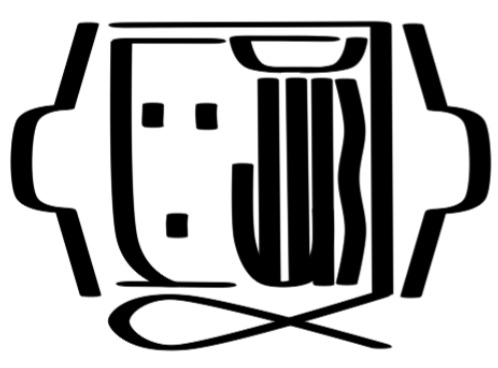
Jalzègxa (n)
/ˌʒàlzêgˈxà/
Metallic class, second declension
1. chronicle, record, annal
Derived from metallic class marker ja- + łzègxa (lit. "history"), altogether from proto-Seraphic jalisewabřáw (lit. "physical object of history")
Āgxōnr edrelzēwok'u'ōf cu-łsērn fl nedjasa wa-jalzègxan flin.
"The stories of our people have been written in these chronicles."
This is one of my favorite words that I've created, cuz it was really a whole process to get to this point. It's better to explain this with proto-Seraphic, since word boundaries are a bit more clear. It started with the word 'wa' which meant "open". Put it into the solar class to make sewá "mouth". Put that into the lunar class to make lisewá "word". Add the adjective břaw "old" to make lisewabřáw "history". Put that into the metallic class to finally make jalisewabřáw "chronicles". Most word derivation in Seraphic is putting different words into different noun classes. Literally though I guess it means "a physical object of the abstract concept of a person-related opening", but those kind of meanings get lost in the busyness of it all anyways.
1 note
·
View note
Text
Lexember Day 21
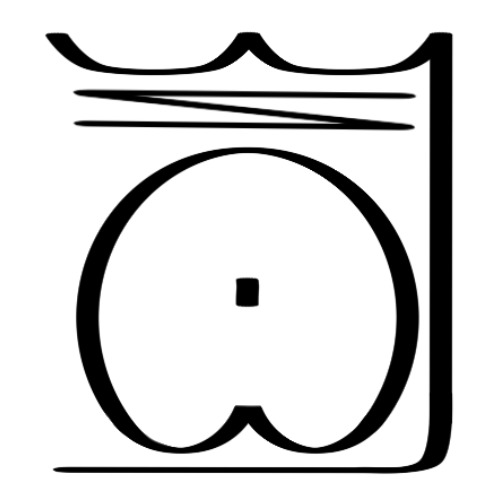
Layux (n)
/làˈjùx/
Lunar class, first declension
1. death, rot
Derived from proto-Seraphic liyúx (lit. "concept of rotting")
Layux nzağok'oman īn-ēt'ān nax cu-lisūc.
"Death is the greatest enemy of life."
This word I actually did create just today! Surprised I didn't already have a word for this yet. I have phrase for "to die" and "to kill", but not the noun for death itself. I think this word is more of a general term, and that Seraphic has different words for different kinds of death. They'd also use this term more often to refer to an accidental or non-natural death, like through disease or injury, in contrast to a natural death. Seraphim are kinda like weird bugs, and they're the kinda bugs that die pretty soon after reproducing, so for them that'd be kinda how a seraphim is *supposed* to die and thus would have a special separate word for it. I don't have it right now, but I'll make it later.
3 notes
·
View notes
Text
Lexember Day 20

Avofağláf (n)
/ˌàvòˈfàɣlǎf/
Oceanic class, sixth declension
1. The Seraph Collective, the Seraph Homeworld and its outlying colonies
Derived from Oceanic class marker a- + vofağláf, the collective plural of vofağl (lit. "planet"). Clipping of the phrase Avofağláf cu-Sērapfāf (lit. "The Collective Worlds of the Seraph Race")
Erel wa-Avofağláf mvofağl.
"Erel is a planet within the Seraph Collective."
As the Seraphim became more technologically advanced, they would start colonizing the other celestial bodies in their solar system. Over time these worlds developed their own languages, cultures, and ideologies that cemented them as being separate from the Homeworld itself. In order to maintain contact and relations with the Homeworld and the outlying colonies, a coalition was naturally formed which eventually became known as the "Seraph Collective", united not by culture or language but by their shared connection as members of the seraph species. In the modern era, travel between the worlds is both markedly convenient with the advent of faster-than-light travel, and expected as adult seraphim will be sent off of their home planet to pursue their passions.
5 notes
·
View notes
Text
Lexember Day 19

Wōk'łts (n)
/wóˈkʼĺ̩t͡s/
Vital class, first declension
1. frostroot
Derived from proto-Seraphic hwiqĺdtsi' (lit. "cold root")
Zāfl fr-lsúr fl fān-vucūf eğrawok'łtsn̄ uvn.
"I dug up some frostroots from the garden this morning."
Frostroot is a term for the violet tubers of the frostroot bush that natively grows around the ancestral region of the Proto-Seraphic culture. When ingested or applied to exposed flesh it causes a sensation of cold temperatures, much akin to the Earth plant mint. However, it's highly toxic to humans and should not be consumed in any quantity.
10 notes
·
View notes
Text
Lexember Day 18

Māzefādnu (n)
/ˌmázèˈfádnù/
Oceanic class, first declension
1. hourglass, sand timer
Borrowed from Modern Mewling mazzefadnï (lit. "falling sand")
Māzefādnu njalp'i nar iğralit'n̄ pr̄-ājt'łvr cu-łsērnin pfan.
"An hourglass is a tool that was used for timekeeping by many ancient cultures."
The Proto-Seraphic culture didn't have any hourglasses or hourglass-like devices. If they needed to keep track of any time shorter than a day, they used sundials. Hourglasses were introduced to them from neighboring cultures who had more access to a surplus of available sand. By the modern era, which has become incredibly advanced, the use of hourglasses and sundials have been rendered so obsolete that many wouldn't be able to recognize one if they were shown it. Even physical clocks are seen as ancient relics.
8 notes
·
View notes
Text
Lexember Day 17

Łp'ē (n)
/ĺ̩ˈpʼé/
Lunar class, third declension
1. music
Borrowed from Eldermewling ipey (lit. "music"). Replaced native proto-Seraphic liŋisń (modern Collective Seraphic lnsn̄, lit. "song, poem")
Zāfl pi-znoŋa xōzl ēdrelp'ē.
"I don't listen to music very often."
Another loanword, yay! I think this word came about because the Seraphic speakers wanted a way to distinguish songs from all music, e.g. orchestral and instrumental work. The old word is still used to mean "song" or "poem" (they're essentially the same thing in Seraphic).
2 notes
·
View notes